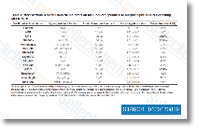These include the pan PI3K inhibitors BKM120, XL 147, PX 866, PKI 587, and GDC 0941, the p110 specific inhibitors BYL719, GDC 0032, and INK 1117, the p110 distinct inhibitor CAL 101, along with the dual PI3K/mTOR inhibitors BEZ235, BGT226, PF 4691502, GDC 0980, and XL 765. The pan PI3K and p110 particular inhibitors are equally potent against oncogenic p110 mutants. The rationale for that growth of isozyme precise antagonists is always to permit greater doses of anti p110 and anti p110B drugs to become delivered without incurring side effects brought on by pan PI3K inhibitors. Interim benefits from a phase I trial with the p110 specific inhibitor CAL 101 in individuals with hematologic malignancies showed that treatment decreased P AKT levels 90% in peripheral blood lymphocytes and induced goal clinical responses.
selleck Lately finished phase I trials with BKM120, BEZ235, and XL 147 showed that remedy partially inhibited PI3K as measured by ranges of P S6 and P AKT in patientsskin or tumors, and 2 deoxy two fluoro D glucose uptake measured by PET. Principal toxicities were rash, hyperglycemia, diarrhea, fatigue and, mood alterations. Couple of clinical responses had been observed in patients with and with out detectable PI3K pathway mutations, selleck inhibitor although screening for genetic lesions in this pathway was not thorough. The two allosteric and ATP aggressive pan inhibitors on the 3 isoforms of AKT can also be remaining created. AZD5363, GDC 0068, GSK2141795, and GSK690693 are ATP aggressive compounds that have shown antitumor activity in preclinical designs and not too long ago entered phase I trials. Allosteric inhibitors which include MK 2206 bind for the AKT PH domain and/or hinge area to advertise an inactive conformation with the AKT protein that is unable to bind towards the plasma membrane.
MK 2206 inhibits  AKT signaling in vivo, and suppresses development of breast cancer xenografts harboring PIK3CA mutations or ERBB2 amplification. Phase I information showed that treatment with MK 2206 decreases ranges of P AKT, P PRAS40, and P GSK3B in tumor cells, peripheral blood mononuclear cells, and hair follicles. The mTOR kinase is a part of PI3K driven oncogenesis that functions inside of two signaling complexes, TORC1 and TORC2. The macrolide rapamycin and its analogs type complexes with FK506 binding protein. This complicated then binds to mTOR and inhibits the kinase activity of TORC1 but not TORC2. Formulation issues of rapamycin prompted the development of analogs for example CCI 779, RAD001, AP 23573, and MK 8669. These rapalogs have proven cytostatic action in preclinical designs and clinical trials, specifically in individuals with renal cell cancer, and in patients with mutations inside the TSC complicated who harbor renal angiolipomas.
AKT signaling in vivo, and suppresses development of breast cancer xenografts harboring PIK3CA mutations or ERBB2 amplification. Phase I information showed that treatment with MK 2206 decreases ranges of P AKT, P PRAS40, and P GSK3B in tumor cells, peripheral blood mononuclear cells, and hair follicles. The mTOR kinase is a part of PI3K driven oncogenesis that functions inside of two signaling complexes, TORC1 and TORC2. The macrolide rapamycin and its analogs type complexes with FK506 binding protein. This complicated then binds to mTOR and inhibits the kinase activity of TORC1 but not TORC2. Formulation issues of rapamycin prompted the development of analogs for example CCI 779, RAD001, AP 23573, and MK 8669. These rapalogs have proven cytostatic action in preclinical designs and clinical trials, specifically in individuals with renal cell cancer, and in patients with mutations inside the TSC complicated who harbor renal angiolipomas.
Peptides Price
A gene coding for a selectable marker such as antibiotic resistance is also incorporated into the vector.
